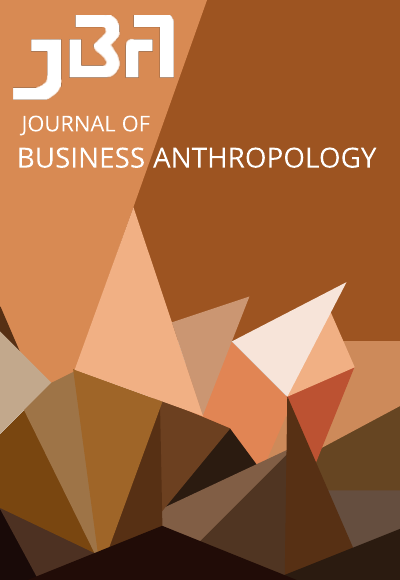The (Re)making of Flow: Mediator Companies and Knowledge Production
DOI:
https://doi.org/10.22439/jba.v6i2.5412Keywords:
Flow, Knowledge production, Mediator companies, Hybridity, StrathernAbstract
This article concerns the (re)making of the flow of knowledge by structural biologists employed in a mediator company located between the university domain and the business world in Sweden. Drawing on Marilyn Strathern’s theory of ‘cutting the flow’, this article ethnographically studies the flow of knowledge: how it is locally made, stopped, and remade in the laboratory. The first part reflects on the author’s learning process during the fieldwork, while the second part discusses the hybrid position of mediator companies and the practices of associated researchers. The third part investigates the status of these companies among policymakers and life science stakeholders. The fourth and fifth parts ethnographically describe the cut and the (re)making of the flow of knowledge in everyday laboratory work. Taken together, these five parts will result in an attempt to extend Strathern’s theoretical approach.
References
Appadurai, A. 1996. Modernity at large: cultural dimensions of modernity. Minneapolis: University of Minnesota Press.
Bateson, G. 2000. Steps to an Ecology of Mind. Chicago: The University of Chicago Press.
Bhahba, H. 1994. The Location of Culture. London: Routledge.
Bourdieu, P. 1990. Homo Academicus. Stanford: Stanford University Press.
Cefkin, M. 2010. Ethnography and the Corporate Encounter. New York: Berghahn Books.
Edward, W. Soja. 1996. Thirdspace: Journeys to Los Angeles and Other Real-and-Imagined Places. Oxford: Basil Blackwell.
Galison, P. 1997. Image & Logic: A material culture of microphysics. Chicago: The University of Chicago Press.
Gell, A. 2006. The Art of Anthropology: Essays and Diagrams. Oxford: Berg.
Hacking, I. 1983. Representing and Intervening: Introductory topics in the philosophy of natural science. Cambridge: Cambridge University Press. https://doi.org/10.1017/cbo9780511814563
Hallonsten, O. (ed.). 2012. In Pursuit of a Promise: Perspectives on the political process to establish the European Spallation Source (ESS) in Lund, Sweden. Lund: Arkiv förlag.
Hannerz, U. 1992. Cultural Complexity. New York: Columbia University Press.
Hine, C. 2001. Ethnography in the laboratory. In Inside Organizations: Anthropologists at work, edited by David N. Gellner and Eric Hirsch, pp. 61-76. Oxford: Berg,
Kaiserfeld, T. and T. O’Dell. 2013. Legitimizing ESS: Big science as collaboration across boundaries. Lund: Nordic Academic Press.
Knorr Cetina, K. 1999. Epistemic Cultures: How the sciences make knowledge. Massachusetts: Harvard University Press.
Sunder Rajan, K. 2006. Biocapital: The Constitution of Post-genomic Life. Durham, NC: Duke University Press. https://doi.org/10.1215/9780822388005
Latour, B. 1987. Science in Action. Massachusetts: Harvard University Press.
Liljas A., L. Liljas, J. Piskur and P. Nissen. 2009. Texbook of Structural Biology. Singapore: World Scientific Publishing. https://doi.org/10.1142/6620
Muthian, S. 2014. State of Translational Research Survey Report. Report, Sigma-Aldrich Corporation. Nationalencyklopedin. 1995. Höganäs: Bokförlaget Bra Böcker AB.
Pedersen, M. A. 2013. The fetish of connectivity. In Objects and Materials: A Routledge Companion, edited by Gillian Evans, Elizabeth Silva and Nick Thoburn, pp. 197-207. London: Routledge.
Rabinow, P. 1996. Making PCR: A Story of Biotechnology. Chicago: The University of Chicago Press.
Rockefeller, S. 2011. Flow. Current Anthropology 52(4): 557-578. https://doi.org/10.1086/660912
Sennett, R. 2008. The Craftsman. London: Penguin Books.
Shapin. S. 2010. The Scientific Life: A Moral History of a Late Modern Vocation. Chicago: The University of Chicago Press.
Strathern, M. 1996. Cutting the network. The Journal of the Royal Anthropological Institute 2(3): 517-535. https://doi.org/10.2307/3034901
Strathern, M. 2004. Commons and Borderlands: Working papers on interdisciplinarity and the flow of knowledge. Oxon: Sean King Publishing.
Strathern, M. 2006. A Community of Critics? Thoughts on New Knowledge. Journal of the Royal Anthropological Institute(N.S.) 12(1): 191-209. https://doi.org/10.1111/j.1467-9655.2006.00287.x
Traweek, S. 1992. Beamtimes and Lifetimes: The world of high energy physicists. Massachusetts: Harvard University Press.
Unesco. 2014. Crystals shape our world. http://www.unesco.org/new/en/natural-sciences/science-technology/basic-sciences/infocus-bes/international-year-of-crystallography-2014/
Urban, G. 2016. Corporations in the Flow of Culture. Seattle University Law Review 39: 321—351.
Downloads
Published
Issue
Section
License
Authors who publish with this journal agree to the following terms:
- Authors retain copyright and grant the journal right of first publication with the work simultaneously licensed under a Creative Commons Attribution License that allows others to share the work with an acknowledgement of the work's authorship and initial publication in this journal.
- Authors are able to enter into separate, additional contractual arrangements for the non-exclusive distribution of the journal's published version of the work (e.g., post it to an institutional repository or publish it in a book), with an acknowledgement of its initial publication in this journal.
- Authors are permitted and encouraged to post their work online (e.g., in institutional repositories or on their website) prior to and during the submission process, as it can lead to productive exchanges, as well as earlier and greater citation of published work (See The Effect of Open Access).



